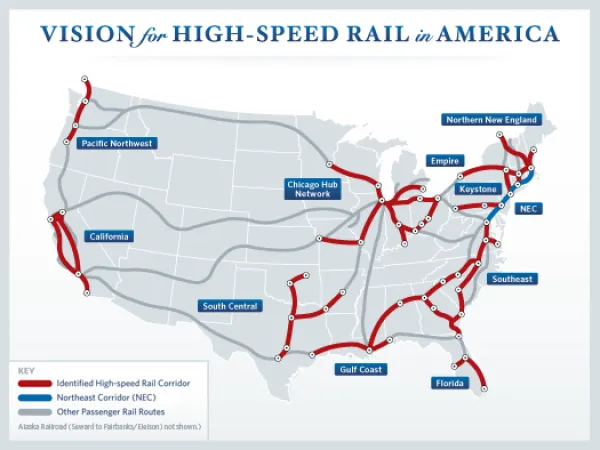Image

History has been made in our lifetime. When President Obama came to office in 2009, he had a progressive agenda that included implementing a national high speed rail plan. Many of his platforms became unsuccessful bargaining chips and the high speed rail plan was hardly popular on both sides of the isle. Three Republican governors effectively halted the plan by rescinding astronomical amounts of money that would have improved high speed travel in their respective states. People from Wisconsin, Florida and, of course, Ohio have lost opportunities to move around their states without disrupting the climate on the road or frequently paying more for airfare. Ohio is vying for high-speed rail yet again though.
Columbus is situated in a central position relative to cities in Ohio and across state lines. The third largest city in the country, Chicago, is only 350 miles away. While in the air, these cities seem worlds away, and their communities become completely disconnected. And although the road can be exhilarating- and other times exhausting- an identified high speed rail line could get passengers to their destination in only three and a half hours. By increasing connectivity to Chicago, I believe Columbus can use the train as an opportunity to continue its growth and expand its industries.
Still Without Rail
Often we are reminded that Columbus is the largest city without passenger rail. Since Mayor Michael Coleman has come to office, he has initiated and supported rail projects throughout the Columbus Metropolitan area. After a decade in office, the capital city remains without rail. Recently, our city administration has begun considering rail again.
I discussed the HSR project with the Mayor Coleman's Director of Regional Initiatives, Steve Campbell, and our conversation revolved around a central theme of how the benefits from the project will cross jurisdictions outside of Columbus. Cities along the route, such as Lima and Marysville can benefit tremendously. Lima Mayor David Berger realized this and helped allocate money for the initial feasibility study.
If completed, Lima and Marysville will have an increased ability to tap into world-class medical and academic institutions that operate in Columbus. Here, job centers are much more plentiful outside of the manufacturing industries. Some of those industries include finance, insurance and research and development. Entertainment abounds in the Capital city as well. Can Columbus benefit from Chicago in similar ways though?
Evidence abounds that Columbus is ready to access new Midwestern and international markets, which can be done by increasing face-to-face interactions with train-traveling business people. Venture capitalists could reach Columbus using a more affordable mode. With hotel capacity increasing near the convention center, high-speed rail would make the venue even more attractive.
Opponents of the rail line have suggested building a new highway for car and truck traffic, but there are already available highway routes from Ohio through Indiana and on to Illinois. The HSR route has been deemed financially sustainable, feasible, and in this regard, building a new highway is out of the question. Revenues collected from the gas tax are unable to cover maintenance costs of our existing roads and bridges, let alone finance new construction. According to the Federal Highway Administration, new highway construction in urban areas ranges between $12 million and $15 million per road mile. It is entirely unsound then to build even a mile of highway considering only $60,000 a year in gas taxes are generated per road mile. Central Ohio has one and a half million people who can access viable, quick transportation to Chicago and to other cities along the high-speed route.
As mentioned before, a feasibility study, initiated by the Northeast Indiana Passenger Rail Association, was completed and had results that reinforce the project's strength. Fort Wayne, Indiana, Columbus, Lima and other cities and organizations helped fund a study that determined within three years, the route can be financially sustainable. Another study is required, the Environmental Impact Study, which will allow the corridor to be funded up to 80 percent by the Federal Railway Administration, which funds new and upgraded tracks, bridges and other physical rail infrastructure. An excellent video made by a Columbus news station, WBNS, shows a short interview with a member of NIPRA discussing the benefits of the train.
“ The project is solid,” Steve Campbell said as he shared exciting details on a recent conversation between the Ohio Department of Transportation about bringing HSR to Columbus. He told me his department presented its business case and briefed ODOT on the project's details. After establishing the costs and benefits with ODOT, it would be hard for the entity to justify not allocating a portion of its almost $3 billion annual transportation budget.
